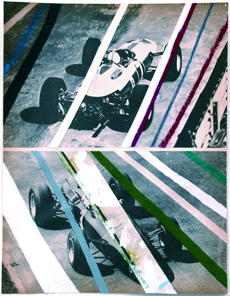Sam Martineau, Anne Deleporte draw inspiration from familiar print media imagery
Two artists who paint on material culled from newspapers and magazines have exhibitions in the Williamsburg gallery area. At Roebling Hall, Anne Deleporte commands the entire cavernous gallery. At Brooklyn Fire Proof, Sam Martineau has about a dozen framed works in the projects area adjacent to the gallery’s principal exhibition space.
Deleporte is French and has an international exhibition record. In her first New York installation, she has adhered flattened newspaper pages to most of the gallery walls. She used the Village Voice and The New York Times, as she has done in her installations in other locales with their newspapers. Deleporte covers them with substantial coats of baby blue latex house paint and only leaves selected imagery, calligraphy, or other carefully limned areas of the newsprint exposed. Little graphic events seem to pop out all over the gallery. The press release calls them “photo-frescoes” and describes the overall effect as like constellations in a blue sky.
The images cohere into strangely familiar celestial presences. They are the ads, photographs, and text that we see every day and every day is impermanent, the work seems to imply. The exhibition will end and the house paint and newsprint will yellow. Deleporte’s painted-paper firmament is already on the wane. So too are our lives. Much contemporary French work has similar qualities of poetry, materiality, and economy. Simple means evoking many meanings. It is our loss that not more of it is seen here.
Sam Martineau, a young, sophisticated American, titled his exhibition “Slip Down Easy.” Like Matisse wanting to make art that is like “a comfortable armchair,” Martineau’s title indicates that artistic ambition can keep the idea of pleasure at the forefront. Most of the show is taken up by a group of eight collages of equal size hung in a double row along one wall. Each work uses one sheet of Indianapolis and Daytona Beach racing images that came two per page in a car magazine. The thin white horizontal line dividing the two photographs on each page allows a grid-like structure to emerge from the overall hanging of the series.
Martineau adds geometrical and abstract patterns on the pages with crayon, paint, and cut paper. His use of commercial racing car pictures comments on his own process. Racing cars are fast-moving collages with numbers, stripes, and racing stickers stuck all over their surfaces.
Some additions counterpoint or subtly accentuate the essential gesture of the photographs. These superimpositions tend to slow the active imagery down. Between the visceral cars and delicately gluey paint, swerving roadways and shards of cut paper, the resulting effect is that of a series of sensuous near-collisions.
Both shows are exemplary in their delight in the properties of humble materials and in their confidence in the rewards of improvisation.
gaycitynews.com




































